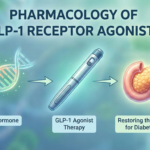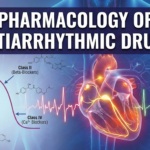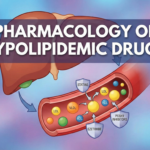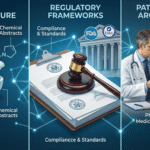Introduction
Have you ever wondered about the drugs that counteract the effects of the sympathetic nervous system? Sympatholytics, also known as adrenergic antagonists, are one such class of drugs. This article will dive into the classification, pharmacological actions, clinical uses, adverse effects, and contraindications of different types of sympatholytic drugs. So, let’s get started!
Sympatholytics Classification
Sympatholytics can be broadly classified into three categories:
- Alpha-Adrenergic Antagonists
- Beta-Adrenergic Antagonists
- Centrally Acting Sympatholytics
Alpha-adrenergic antagonists
Pharmacological Actions
Alpha-adrenergic antagonists, or alpha-blockers, work by blocking alpha-adrenergic receptors. This leads to vasodilation, decreased peripheral resistance, and reduced blood pressure. There are two subtypes of alpha-adrenergic antagonists: selective alpha-1 antagonists (e.g., prazosin, terazosin) and non-selective alpha antagonists (e.g., phentolamine, phenoxybenzamine).
Clinical Uses
Alpha-adrenergic antagonists are used in the treatment of various conditions, including:
- Hypertension
- Benign prostatic hyperplasia (BPH)
- Raynaud’s disease
- Pheochromocytoma
Adverse Effects
Some of the common adverse effects of alpha-adrenergic antagonists are:
- Orthostatic hypotension
- Dizziness
- Headache
- Nasal congestion
- Reflex tachycardia (non-selective alpha antagonists)
Contraindications
Alpha-adrenergic antagonists should be used with caution in patients with:
- Heart failure
- Coronary artery disease
- History of syncope or falls
Beta-adrenergic antagonists (beta-blockers)
Pharmacological Actions
Beta-adrenergic antagonists, also known as beta-blockers, inhibit the action of catecholamines on beta-adrenergic receptors. This results in decreased heart rate, contractility, and cardiac output. Beta-blockers can be classified into selective beta-1 antagonists (e.g., atenolol, metoprolol) and non-selective beta antagonists (e.g., propranolol, nadolol).
Clinical Uses
Beta-adrenergic antagonists are utilized for various medical conditions, including:
- Hypertension
- Angina pectoris
- Heart failure
- Arrhythmias
- Myocardial infarction
- Migraine prophylaxis
- Hyperthyroidism
- Anxiety (such as performance anxiety)
- Glaucoma
- Hypertension: lower blood pressure by reducing the activity of the sympathetic nervous system. Examples of sympatholytics used for hypertension include beta-blockers such as atenolol and metoprolol, alpha-blockers such as doxazosin and prazosin, and centrally-acting drugs such as clonidine and methyldopa.
- Angina Pectoris: can also be used to treat angina pectoris, a condition characterized by chest pain due to reduced blood flow to the heart. Beta-blockers are commonly used to reduce the workload of the heart and decrease oxygen demand. Examples of beta blockers used for angina include propranolol and bisoprolol.
- Heart Failure: can also be used to treat heart failure, a condition in which the heart is unable to pump enough blood to meet the body’s needs. Beta-blockers can be used to decrease the workload of the heart and improve cardiac function. Examples of beta blockers used for heart failure include carvedilol and metoprolol.
- Arrhythmias: can be used to treat arrhythmias or abnormal heart rhythms. Beta-blockers are often used to slow down the heart rate and reduce the risk of ventricular fibrillation. Examples of beta blockers used for arrhythmias include propranolol and sotalol.
- Myocardial Infarction: can be used to treat myocardial infarction or heart attack. Beta-blockers are commonly used to reduce the workload of the heart and prevent further damage. Examples of beta blockers used for myocardial infarction include atenolol and metoprolol. However, beta-blockers are contraindicated in acute heart failure.
- Migraine Prophylaxis: can be used to prevent migraines, a type of headache that is often associated with sympathetic activation. Beta-blockers can be used to reduce the frequency and severity of migraines. Examples of beta blockers used for migraine prophylaxis include propranolol and timolol.
- Hyperthyroidism: can be used to treat hyperthyroidism, a condition in which the thyroid gland produces too much thyroid hormone. Beta-blockers can be used to alleviate symptoms such as rapid heart rate and tremors. Examples of beta blockers used for hyperthyroidism include propranolol and atenolol.
- Anxiety: can be used to treat anxiety, a condition characterized by excessive sympathetic activity. Beta-blockers can be used to reduce the physical symptoms of anxiety, such as rapid heart rate and sweating. Examples of beta blockers used for anxiety include propranolol and atenolol.
- Glaucoma: can also be used to treat glaucoma, a condition in which high pressure within the eye can damage the optic nerve and lead to vision loss. Beta-blockers can be used to reduce intraocular pressure by decreasing the production of aqueous humor. Examples of beta blockers used for glaucoma include timolol and betaxolol.
Adverse Effects
Some common adverse effects associated with beta-adrenergic antagonists are:
- Bradycardia
- Hypotension
- Fatigue
- Cold extremities
- Bronchospasm (non-selective beta antagonists)
Contraindications
Beta-adrenergic antagonists should be avoided or used with caution in patients with:
- Asthma or chronic obstructive pulmonary disease (COPD)
- Severe bradycardia
- Second or third-degree heart block
- Decompensated heart failure
- Acute heart failure
Centrally Acting Sympatholytics
Pharmacological Actions
Centrally acting sympatholytics inhibit the sympathetic nervous system by acting on the central nervous system (CNS). They reduce the release of norepinephrine, resulting in decreased sympathetic outflow. Examples of centrally acting sympatholytics include clonidine, methyldopa, and guanfacine.
Clinical Uses
Centrally acting sympatholytics are primarily used for:
- Hypertension
- Opioid withdrawal management
- Attention deficit hyperactivity disorder (ADHD) in children (e.g., guanfacine)
Adverse Effects
Some common adverse effects of centrally acting sympatholytics are:
- Drowsiness
- Dry mouth
- Constipation
- Rebound hypertension upon abrupt withdrawal
Contraindications
Centrally acting sympatholytics should be avoided or used cautiously in patients with:
- Severe bradycardia
- History of depression
- Severe hepatic or renal impairment
Conclusion
Sympatholytics are an important class of drugs that counteract the effects of the sympathetic nervous system. They are classified into alpha-adrenergic antagonists, beta-adrenergic antagonists, and centrally-acting sympatholytics. Each group has unique pharmacological actions, clinical uses, adverse effects, and contraindications. Understanding these differences is crucial for safely and effectively using these medications in various medical conditions.
Quiz on sympatholytics
📚 AI Pharma Quiz Generator
🎉 Quiz Results
Medical Disclaimer
The medical information on this post is for general educational purposes only and is provided by Pharmacology Mentor. While we strive to keep content current and accurate, Pharmacology Mentor makes no representations or warranties, express or implied, regarding the completeness, accuracy, reliability, suitability, or availability of the post, the website, or any information, products, services, or related graphics for any purpose. This content is not a substitute for professional medical advice, diagnosis, or treatment; always seek the advice of your physician or other qualified health provider with any questions you may have regarding a medical condition and never disregard or delay seeking professional advice because of something you have read here. Reliance on any information provided is solely at your own risk.










